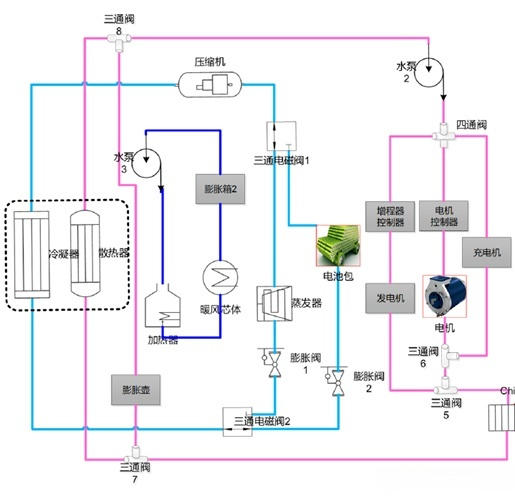The thermal management system of pure electric vehicles not only ensures a comfortable driving environment for the driver, but also controls the temperature, humidity, air supply temperature, etc. of the indoor environment. It mainly controls the temperature of the power battery. The temperature control of the power battery is to ensure the safety of the electric vehicle. An important prerequisite for efficient and safe operation of automobiles.
There are many cooling methods for power batteries, which can be divided into air cooling, liquid cooling, heat sink cooling, phase change material cooling and heat pipe cooling.
Temperature that is too high or too low will affect the performance of lithium-ion batteries, but different temperatures have different effects on the internal structure of the battery and ion chemical reactions.
At low temperatures, the ionic conductivity of the electrolyte during charge and discharge is low, and the impedances at the positive electrode/electrolyte interface and negative electrode/electrolyte interface are high, which affects the charge transfer impedance on the positive and negative electrode surfaces and the diffusion of lithium ions in the negative electrode. speed, ultimately affecting key indicators such as battery rate discharge performance and charge and discharge efficiency. At low temperatures, part of the solvent in the battery's electrolyte will solidify, making it difficult for lithium ions to migrate. As the temperature drops, the electrochemical reaction impedance of the electrolyte salt will continue to increase, and the dissociation constant of its ions will also continue to decrease. These factors will seriously affect The movement rate of ions in the electrolyte reduces the electrochemical reaction rate; and during the charging process of the battery at low temperature, the difficulty in lithium ion migration will trigger the reduction of lithium ions into metallic lithium dendrites, resulting in the decomposition of the electrolyte and increased concentration polarization. Moreover, the sharp angles of this lithium metal dendrite can easily pierce the internal separator of the battery, causing a short circuit within the battery and causing a safety accident.
High temperature will not cause the electrolyte solvent to solidify, nor will it reduce the diffusion rate of electrolyte salt ions; on the contrary, high temperature will increase the electrochemical reaction activity of the material, increase the ion diffusion rate, and accelerate the migration of lithium ions, so in a sense High temperatures help improve the charge and discharge performance of lithium-ion batteries. However, when the temperature is too high, it will accelerate the decomposition reaction of the SEI film, the reaction between the lithium-embedded carbon and the electrolyte, the reaction between the lithium-embedded carbon and the adhesive, the decomposition reaction of the electrolyte and the decomposition reaction of the cathode material, thus seriously affecting the service life and performance of the battery. Use performance. The above reactions are almost all irreversible. When the reaction rate is accelerated, the materials available for reversible electrochemical reactions inside the battery will be rapidly reduced, causing the battery performance to decline in a short period of time. And when the battery temperature continues to rise beyond the battery safety temperature, the decomposition reaction of the electrolyte and electrodes will spontaneously occur inside the battery, which will generate a large amount of heat in a very short period of time, that is, thermal failure of the battery will occur, which will cause the battery to be completely destroyed. . In the small space of the battery box, the heat is difficult to dissipate in time, and the heat accumulates rapidly in a short period of time. This is very likely to cause the rapid spread of thermal failure of the battery, causing the battery pack to smoke, spontaneously ignite or even explode.

The thermal management control strategy of pure electric vehicles is: The power battery cold start process is: before starting the electric vehicle, the BMS checks the temperature of the battery module and compares the average temperature value of the temperature sensor with the target temperature. If the average temperature of the current battery module If the temperature is higher than the target temperature, the electric vehicle can start normally; if the average temperature value of the sensor is lower than the target temperature, the PTC EV heater needs to be turned on to start the preheating system. During the heating process, the BMS monitors the temperature of the battery at all times. As the battery temperature rises during the operation of the preheating system, when the average temperature of the temperature sensor reaches the target temperature, the preheating system stops working.
Post time: May-09-2024




